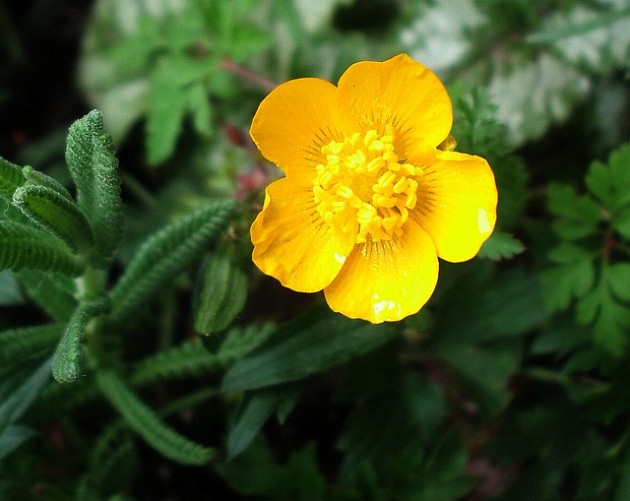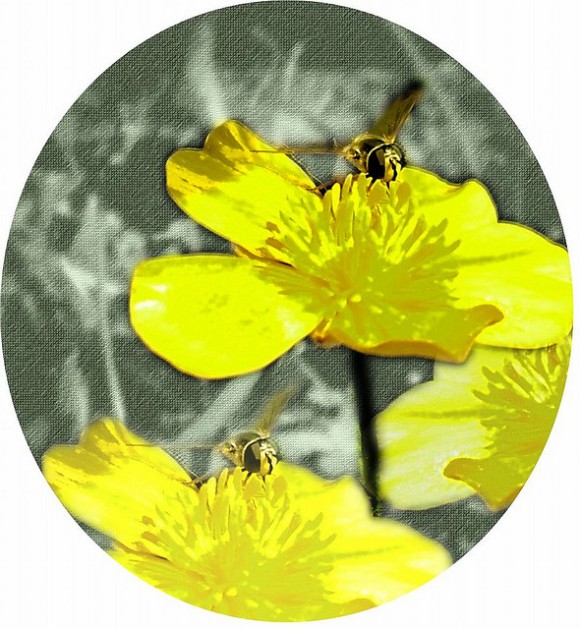Ranunculus /ræˈnʌŋkjʊləs/is a large genus of about 600 species of plants in the Ranunculaceae. Members of the genus include the buttercups, spearworts, water crowfoots and the lesser celandine.
Scientific classification
Kingdom: Plantae
(unranked): Angiosperms
(unranked): Eudicots
Order: Ranunculales
Family: Ranunculaceae
Genus: Ranunculus
They are mostly herbaceous perennials with bright yellow or white flowers (if white, still with a yellow centre); some are annuals or biennials. A few species have orange or red flowers. There are usually five petals, but sometimes six, numerous, or none, as in R. auricomus. The petals are often highly lustrous, especially in yellow species. Buttercups usually flower in the spring, but flowers may be found throughout the summer, especially where the plants are growing as opportunistic colonizers, as in the case of garden weeds.
The Water crowfoots (Ranunculus subgenus Batrachium), which grow in still or running water, are sometimes treated in a separate genus Batrachium (from Greek batrachos βάτραχος: frog, etymology comparable to ranunculus itself). They have two different leaf types, thread-like leaves underwater and broader floating leaves. In some species, such as R. aquatilis, a third, intermediate leaf type occurs.
Ranunculus species are used as food plants by the larvae of some Lepidoptera species including Hebrew Character and Small Angle Shades. Some species are popular ornamental flowers in horticulture, with many cultivars selected for large and brightly coloured flowers
Naming
The name Ranunculus is Late Latin for “little frog,” from rana “frog” and a diminutive ending. This probably refers to many species being found near water, like frogs.
The name buttercup may derive from a false belief that the plants give butter its characteristic yellow hue (in fact it is poisonous to cows and other livestock). A popular children’s game involves holding a buttercup up to the chin; a yellow reflection is supposed to indicate fondness for butter.
In the interior of the Pacific Northwest of the United States the buttercup is called “Coyote’s eyes” — ʔiceyéeyenm sílu in Nez Perce and spilyaynmí áčaš in Sahaptin. In the legend Coyote was tossing his eyes up in the air and catching them again when Eagle snatched them. Unable to see, Coyote made eyes from the buttercup.[citation needed]
Splitting of the genus
Molecular investigation of the genus has revealed that Ranunculus is not monophyletic with respect to a number of other recognized genera in the family – e.g. Ceratocephala, Halerpestes, Hamadryas, Laccopetalum, Myosurus, Oxygraphis, Paroxygraphis and Trautvetteria. A proposal to split Ranunculus into several genera have thus been published in a new classification for the tribe Ranunculeae. The split (and often re-recognized) genera include Arcteranthis Greene, Beckwithia Jeps., Callianthemoides Tamura, Coptidium (Prantl) Beurl. ex Rydb., Cyrtorhyncha Nutt. ex Torr. & A.Gray, Ficaria Guett., Krapfia DC., Kumlienia E.Greene and Peltocalathos Tamura.
Toxicity
All Ranunculus species are poisonous when eaten fresh by cattle, horses, and other livestock, but their acrid taste and the blistering of the mouth caused by their poison means they are usually left uneaten. Poisoning can occur where buttercups are abundant in overgrazed fields where little other edible plant growth is left, and the animals eat them out of desperation. Symptoms include bloody diarrhea, excessive salivation, colic, and severe blistering of the mucous membranes and gastrointestinal tract. When Ranunculus plants are handled, naturally occurring ranunculin is broken down to form protoanemonin, which is known to cause contact dermatitis in humans and care should therefore be exercised in extensive handling of the plants. The toxins are degraded by drying, so hay containing dried buttercups is safe.
Selected species list
- Ranunculus abortivus – littleleaf buttercup
- Ranunculus aconitifolius – aconite-leaf buttercup
- Ranunculus acraeus – a newly described species from Otago, New Zealand
- Ranunculus acris – meadow buttercup
- Ranunculus alismifolius – plantainleaf buttercup
- Ranunculus andersonii – Anderson’s buttercup
- Ranunculus aquatilis – common water crowfoot
- Ranunculus arvensis – corn buttercup
- Ranunculus asiaticus – Persian buttercup
- Ranunculus auricomus – Goldilocks buttercup (type species)
- Ranunculus biternatus – Antarctic buttercup
- Ranunculus bonariensis – Carter’s buttercup
- Ranunculus bulbosus – bulbous buttercup
- Ranunculus calandrinioides – high alpine buttercup
- Ranunculus californicus – California buttercup
- Ranunculus canus – Sacramento Valley buttercup
- Ranunculus cassubicus – Kashubian buttercup
- Ranunculus crassipes – subantarctic buttercup
- Ranunculus cymbalaria – marsh buttercup
- Ranunculus eschscholtzii – alpine buttercup
- Ranunculus ficaria – lesser celandine
- Ranunculus flabellaris – yellow water buttercup
- Ranunculus flammula – lesser spearwort
- Ranunculus fluitans – river water crowfoot
- Ranunculus glaberrimus – sagebrush buttercup
- Ranunculus glacialis – glacier buttercup
- Ranunculus gormanii – Gorman’s buttercup
- Ranunculus hebecarpus – delicate buttercup
- Ranunculus hispidus – bristly buttercup
- Ranunculus hydrocharoides – frogbit buttercup
- Ranunculus jovis – Utah buttercup
- Ranunculus kadzusensis – makino, maehwamarum
- Ranunculus lapponicus – Lapland buttercup
- Ranunculus lingua – greater spearwort
- Ranunculus lobbii – Lobb’s buttercup
- Ranunculus longirostris – water buttercup
- Ranunculus lyallii – Mount Cook lily, reputedly the largest buttercup
- Ranunculus macounii – Macoun’s buttercup
- Ranunculus micranthus – small-flowered crowfoot
- Ranunculus moseleyi – Moseley’s buttercup
- Ranunculus muricatus – spinyfruit buttercup
- Ranunculus occidentalis – western buttercup
- Ranunculus orthorhynchus – straightbeak buttercup
- Ranunculus papulentus – large river buttercup
- Ranunculus parviflorus – smallflower buttercup
- Ranunculus pedatifidus – birdfoot buttercup
- Ranunculus peltatus – pond water crowfoot
- Ranunculus pensylvanicus – Pennsylvania buttercup
- Ranunculus platanifolius – large white buttercup
- Ranunculus populago – popular buttercup
- Ranunculus pusillus – low spearwort
- Ranunculus pygmaeus – pygmy buttercup
- Ranunculus recurvatus – hooked crowfoot
- Ranunculus repens – creeping buttercup
- Ranunculus rionii – water crowfoot
- Ranunculus sardous – hairy buttercup, Sardinian buttercup
- Ranunculus sceleratus – celery-leaved buttercup
- Ranunculus septentrionalis – swamp buttercup
- Ranunculus sieboldii
- Ranunculus testiculatus – bur buttercup
- Ranunculus thora – Thora buttercup
- Ranunculus trichophyllus Chaix ex Vill. – Thora buttercup
- Ranunculus uncinatus – woodland buttercup



![20170123050651-f09370cbed.[gif-2-mp4.com] 20170123050651-f09370cbed.[gif-2-mp4.com]](https://live.staticflickr.com/428/32472212275_9af8805d25_m.jpg)


